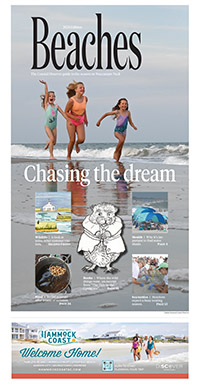Environment
Threatened seabirds create state’s second largest colony on Litchfield Beach

Mary-Catherine Martin looked through her binoculars to see if the chicks had grown their downing feathers.
“Yay!” she said.
The state’s second largest colony of least tern nests sits atop the bare sand on the southern tip of Litchfield Beach. Martin, a wildlife biologist for the state Department of Natural Resources, wants to make sure the 113 nests make it through the season.
She contacted SCUTE, the nonprofit that monitors sea turtle nesting, to help put up 30 wooden posts and string to create a fence around the nests. It was “true village help” for Martin to see volunteers come together to protect the bird that is listed as “threatened” in South Carolina.
“When she needs help, we all grab what we can and go down and help her,” said Rick Scott, head of SCUTE. “We patrol those beaches every day looking for turtles, so we’re in a good position to help her keep an eye on them.”
The fences are meant to discourage beachgoers from walking on the nests or disturbing the nesting colony with activities on the beach.
“We’re not trying to keep you from access, but we’re trying to protect these birds raising their young,” Martin said.
The speckled eggs are almost the same color as the sand, Scott said.
“It’s very hard to see the eggs and chicks,” Martin said.
The idea for installing a protective fence came from examples in Florida and Mississippi, where the nesting colonies had done well because of it. The breeding range includes the Mississippi River, coastal areas of California and stretches down the North Atlantic Ocean from Maine to Florida.
On average, least terns lay 1,000 nests a year in any of these locations with one brood per female.
Most of the eggs at Litchfield were laid at the beginning of May. Some have already hatched. It takes up to 25 days for them to hatch and up to an additional 23 days for the young birds to fly.
Once they can fly out of the area by the third week of July, the least terns return to the Pacific Coast of South America. It’s well worth their time to make the migration to South Carolina because the marsh behind the barrier islands helps the birds regulate their body temperature.
“We give them a lot of attention and help whenever we can,” Martin said.
Seeing more than 100 nests is rare, according to Martin. The average count is between 20 and 30. There are 30 nests this year at Huntington Beach State Park, which has an ongoing program to protect its nesting area.
Scott said SCUTE has noticed least tern nests before this year but in smaller quantities, usually three or four.
“We’ve never seen a colony this big,” he said.
The least tern species typically prefers open areas with water nearby. In Garden City, a colony of 40 nests sit atop a flat, gravel roof. While safe from humans, crows and grackles pose a threat to the chicks.
“It’s hard to say why they choose one location over another,” Martin said. “They have no choice. They’re going to look for something they will feel comfortable in.”
Human disruption is a leading cause of the species’ threatened status. To protect themselves and their eggs or chicks, the least terns fly toward curious bystanders to scare them off, leaving their nest exposed to predators including large birds, rodents, red foxes, raccoons, cats and dogs.
“People will come down there and they’ll see those signs and they’ll be real inquisitive,” Scott said. “We assume they’ll follow the rules and stay away.”
The last trial to see how successful the colonies are this season will be the Fourth of July weekend with an influx of visitors and fireworks that may disturb the least terns.
Martin has seen colonies as big as the one at Litchfield that have failed. She hopes that the signs and fencing will help keep that from happening.
“Let the birds do their thing. There’s plenty of beach left,” Martin said.




